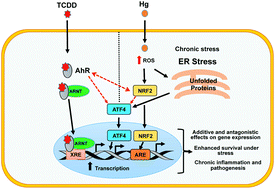Identification of a unique gene expression signature in mercury and 2,3,7,8-tetrachlorodibenzo-p-dioxin co-exposed cells†
Abstract
Mercury (Hg) and 2,3,7,8-tetrachlorodibenzo-p-dioxin (TCDD) are major environmental contaminants that commonly co-occur in the environment. Both Hg and TCDD are associated with a number of human diseases including cancers. While the individual toxicological effects of Hg and TCDD have been extensively investigated, studies on co-exposure are limited to a few genes and pathways. Therefore, a significant knowledge gap exists in the understanding of the deleterious effects of co-exposure to Hg and TCDD. Due to the prevalence of Hg and TCDD co-contamination in the environment and the major human health hazards they pose, it is important to obtain a fuller understanding of genome-wide effects of Hg and TCDD co-exposure. In this study, by performing a comprehensive transcriptomic analysis of human bronchial epithelial cells (BEAS-2B) exposed to Hg and TCDD individually and in combination, we have uncovered a subset of genes with altered expression only in the co-exposed cells. We also identified the additive as well as antagonistic effects of Hg and TCDD on gene expression. Moreover, we found that co-exposure impacted several biological and disease processes not affected by Hg or TCDD individually. Our studies show that the consequences of Hg and TCDD co-exposure on the transcriptional program and biological processes could be substantially different from single exposures, thus providing new insights into the co-exposure-specific pathogenic processes.



 Please wait while we load your content...
Please wait while we load your content...